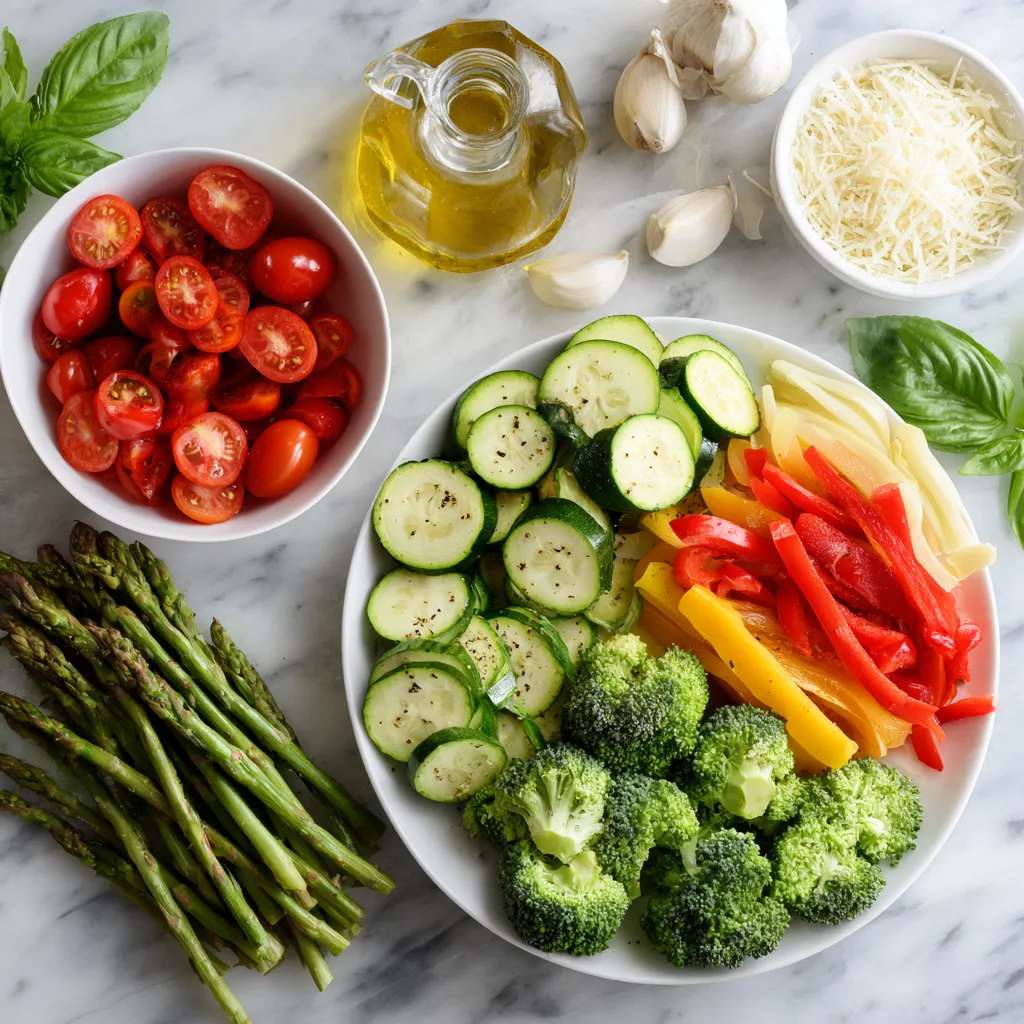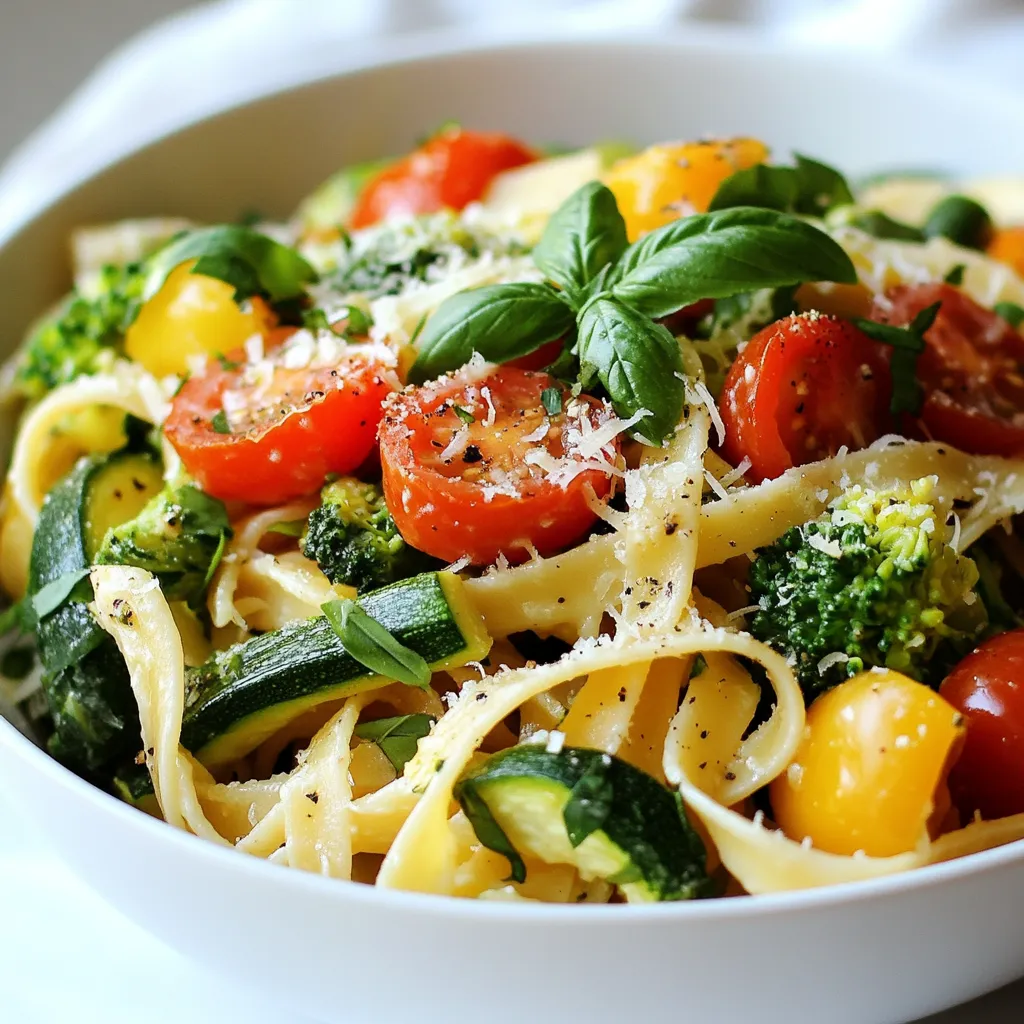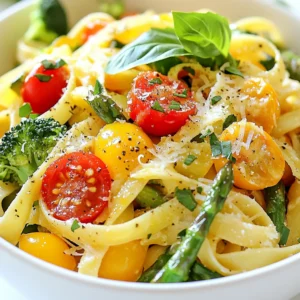WANT TO SAVE THIS RECIPE?
Pasta primavera is the perfect dish for spring! Bursting with fresh veggies and vibrant flavors, it brings the season to your plate. In this guide, I will show you how to create this tasty meal step by step. You’ll learn about the best ingredients, cooking tips, and even ways to customize your pasta. Let’s dive in and enjoy a bowl of bright, delicious pasta primavera together!

Why I Love This Recipe
- Freshness of Ingredients: This pasta primavera showcases vibrant, seasonal vegetables that bring a burst of flavor and nutrients to the dish.
- Quick and Easy: With a total prep and cook time of just 25 minutes, this dish is perfect for busy weeknights or last-minute gatherings.
- Customizable: You can easily swap out vegetables based on what you have on hand or to cater to different tastes, making it versatile.
- Deliciously Light: This recipe offers a healthy yet satisfying meal that doesn’t weigh you down, perfect for any time of the year.
Ingredients
List of Ingredients for Pasta Primavera
To make Pasta Primavera, you need fresh ingredients. Here’s what you need:
– 8 oz spaghetti or fettuccine
– 1 cup cherry tomatoes, halved
– 1 medium zucchini, sliced
– 1 bell pepper (any color), sliced
– 1 cup asparagus, trimmed and cut into 2-inch pieces
– 1 cup broccoli florets
– 2 cloves garlic, minced
– 1/4 cup extra virgin olive oil
– 1 teaspoon Italian seasoning
– Salt and pepper to taste
– Fresh basil leaves, for garnish
– Grated Parmesan cheese (optional)
Fresh vegetables for Pasta Primavera
Fresh vegetables make the dish bright and tasty. Use cherry tomatoes for sweetness. The zucchini adds a nice crunch. Bell peppers bring color and flavor. Asparagus and broccoli add nutrition and texture. Mix and match these veggies as you like!
Spaghetti or fettuccine selection
You can choose between spaghetti or fettuccine. Spaghetti is thin and long, great for twirling. Fettuccine is wider and flat, perfect for holding sauce. Both are delicious in this dish. Pick the one you love!
Optional toppings and garnishes
Garnish your Pasta Primavera with fresh basil leaves. They add a fragrant touch. You can also sprinkle grated Parmesan cheese on top. This adds a creamy, salty flavor. Feel free to get creative with your toppings!

Step-by-Step Instructions
Preparing the Pasta
Start by boiling a large pot of salted water. This helps the pasta taste better. Once the water boils, add your spaghetti or fettuccine. Cook it according to the package instructions. Aim for that perfect al dente texture. When it’s done, reserve half a cup of pasta water. This water helps with the sauce later. After that, drain the pasta and set it aside.
Sautéing the Vegetables
Next, heat a large skillet over medium heat. Pour in the extra virgin olive oil. Let it warm up for a minute. Now add the minced garlic. Cook it until it smells amazing, about one minute. Then, toss in the cherry tomatoes, zucchini, bell pepper, asparagus, and broccoli. Stir in the Italian seasoning, salt, and pepper. Cook everything for about five to seven minutes. You want the veggies to be tender but still colorful.
Combining Pasta and Vegetables
Now it’s time to bring it all together. Add the drained pasta to the skillet. Toss everything gently to mix. If it seems too dry, add some of the reserved pasta water. Do this one tablespoon at a time until you like the sauce’s thickness. Once everything is well combined, take the skillet off the heat. Your vibrant Pasta Primavera is ready to serve!
Tips & Tricks
How to Customize Your Pasta Primavera
You can easily make this dish your own. Try adding protein options like grilled chicken or shrimp. Both add flavor and make the dish more filling. If you want a vegetarian twist, try chickpeas or tofu.
You can also swap out vegetables based on what you have. If zucchini is not in season, use bell peppers or snap peas. Carrots, mushrooms, or even spinach work well too. Just keep the colors bright for a beautiful dish.
Cooking Tips for Perfectly Cooked Pasta
To avoid overcooked noodles, watch the time closely. Cook your pasta until it is al dente. This means it should still have a slight bite. Remember to taste it a minute or two before the package time ends.
Using reserved pasta water can be a game changer. This water is starchy and helps sauces stick. When mixing your pasta and veggies, add a little pasta water at a time. Stir until you reach the right sauce consistency. This keeps your dish creamy without being too heavy.
Pro Tips
- Choose Fresh Vegetables: Opt for seasonal, fresh vegetables for the best flavor and nutritional value.
- Don’t Overcook the Pasta: Cook the pasta al dente to ensure it maintains a slight bite and holds up well with the sauce.
- Customize Your Veggies: Feel free to substitute or add your favorite vegetables to make this dish your own.
- Use Pasta Water Wisely: The reserved pasta water is starchy and helps to create a smooth, cohesive sauce.

Variations
Seasonal Vegetable Variations
You can change the vegetables in Pasta Primavera based on the season. In spring, use fresh asparagus and peas. Summer brings sweet corn and colorful bell peppers. In fall, try roasted butternut squash and kale. Winter calls for hearty veggies like carrots and Brussels sprouts. The key is to pick what is fresh and in season. This will make your dish taste bright and lively.
Dietary Adaptations
If you need gluten-free pasta, look for rice or quinoa pasta. Both options work well in this recipe. For a vegan version, swap the Parmesan cheese with nutritional yeast or a vegan cheese. You can add beans or lentils for protein. These swaps keep the dish tasty while fitting your diet. Adjust the recipe to match your needs and enjoy every bite!
Storage Info
How to Store Leftover Pasta Primavera
To keep your leftover Pasta Primavera fresh, first let it cool down. Place it in an airtight container. Make sure to seal it tightly. Store the container in the refrigerator. It can last for up to three days. If you want to keep it longer, consider freezing it. Use a freezer-safe container, and it can last for up to two months. Just remember to label the container with the date.
Reheating Tips
When it’s time to eat your leftovers, you have a few options to reheat. The stovetop is great for keeping texture. Add a splash of water or olive oil to a pan. Heat it on low and stir often. This helps the pasta stay moist. You can also use the microwave. Place the pasta in a bowl with a little water. Cover it with a damp paper towel. Heat in short bursts, stirring in between. Both methods keep your dish tasty and fresh.
FAQs
What is Pasta Primavera?
Pasta Primavera is a fresh, colorful dish that highlights spring vegetables. The name means “spring pasta” in Italian. This dish first appeared in the 1970s in America. It often features pasta, olive oil, garlic, and a mix of seasonal veggies. The goal is to bring out the bright flavors of the vegetables. You can use any pasta you like, but spaghetti or fettuccine works well.
Can I make Pasta Primavera ahead of time?
Yes, you can prepare Pasta Primavera ahead of time! Cook the pasta and veggies separately. Store them in the fridge. When you’re ready to eat, just reheat them together in a skillet. Add a bit of pasta water to keep it moist. This method saves time and keeps your meal fresh.
What to serve with Pasta Primavera?
Pasta Primavera pairs well with many side dishes. A simple green salad adds freshness. Garlic bread is also a great choice for a satisfying meal. You might even serve it with grilled chicken or shrimp for added protein. Each option enhances the flavors of the pasta.
Pasta Primavera is a fresh, colorful dish that’s easy to make. We explored key ingredients and how to prepare them step by step. Customize it with your favorite proteins or seasonal veggies. Remember to keep the pasta firm and use reserved water for the best texture. Store leftovers properly and follow reheating tips to enjoy another meal. Pasta Primavera shines as a versatile, healthy option for any time of year. Enjoy creating your own versio
Vibrant Vegetable Pasta Primavera
A colorful and healthy pasta dish loaded with fresh vegetables.
Prep Time 10 minutes mins
Cook Time 15 minutes mins
Total Time 25 minutes mins
Course Main Course
Cuisine Italian
Servings 4
Calories 300 kcal
- 8 oz spaghetti or fettuccine
- 1 cup cherry tomatoes, halved
- 1 medium zucchini, sliced
- 1 unit bell pepper (any color), sliced
- 1 cup asparagus, trimmed and cut into 2-inch pieces
- 1 cup broccoli florets
- 2 cloves garlic, minced
- 1 4 cup extra virgin olive oil
- 1 teaspoon Italian seasoning
- to taste unit Salt and pepper
- for garnish unit Fresh basil leaves
- optional unit Grated Parmesan cheese
Begin by bringing a large pot of salted water to a boil. Add the spaghetti or fettuccine, and cook according to package instructions until al dente. Reserve 1/2 cup of pasta water, then drain the pasta and set aside.
In a large skillet, heat the olive oil over medium heat. Add minced garlic and sauté until fragrant, about 1 minute.
Add cherry tomatoes, zucchini, bell pepper, asparagus, and broccoli to the skillet. Stir in Italian seasoning, salt, and pepper. Cook for about 5-7 minutes until the vegetables are tender but still vibrant in color.
Add the cooked pasta to the skillet, tossing everything together to combine. If needed, gradually add reserved pasta water, one tablespoon at a time, until the desired consistency is reached.
Remove the skillet from heat and garnish with fresh basil leaves. Serve warm, topped with grated Parmesan cheese if desired.
Feel free to use any seasonal vegetables you have on hand.
Keyword healthy, pasta, primavera, quick, vegetable
WANT TO SAVE THIS RECIPE?





